Greenhouse Gas in Water Production
VerifiedAdded on 2023/06/11
|12
|3180
|370
AI Summary
This study examines the impact of greenhouse gas on water production and ways to reduce contamination. It analyzes the emission of greenhouse gases during water production, electricity generation, and transportation. The study aims to develop methodologies to calculate GHG emissions and evaluate the impacts of GHGs on the climate over time. The research questions focus on determining the effectiveness of GHGs in trapping gases, evaluating the GHGs associated with water production, and examining the emissions associated with hot water use. The study is significant in developing sustainable practices for clean and safe energy use in water production.
Contribute Materials
Your contribution can guide someone’s learning journey. Share your
documents today.

Running head: GREENHOUSE GAS IN WATER PRODUCTION 1
Greenhouse Gas in Water Production
Student Name
Institutional Affiliation
Greenhouse Gas in Water Production
Student Name
Institutional Affiliation
Secure Best Marks with AI Grader
Need help grading? Try our AI Grader for instant feedback on your assignments.
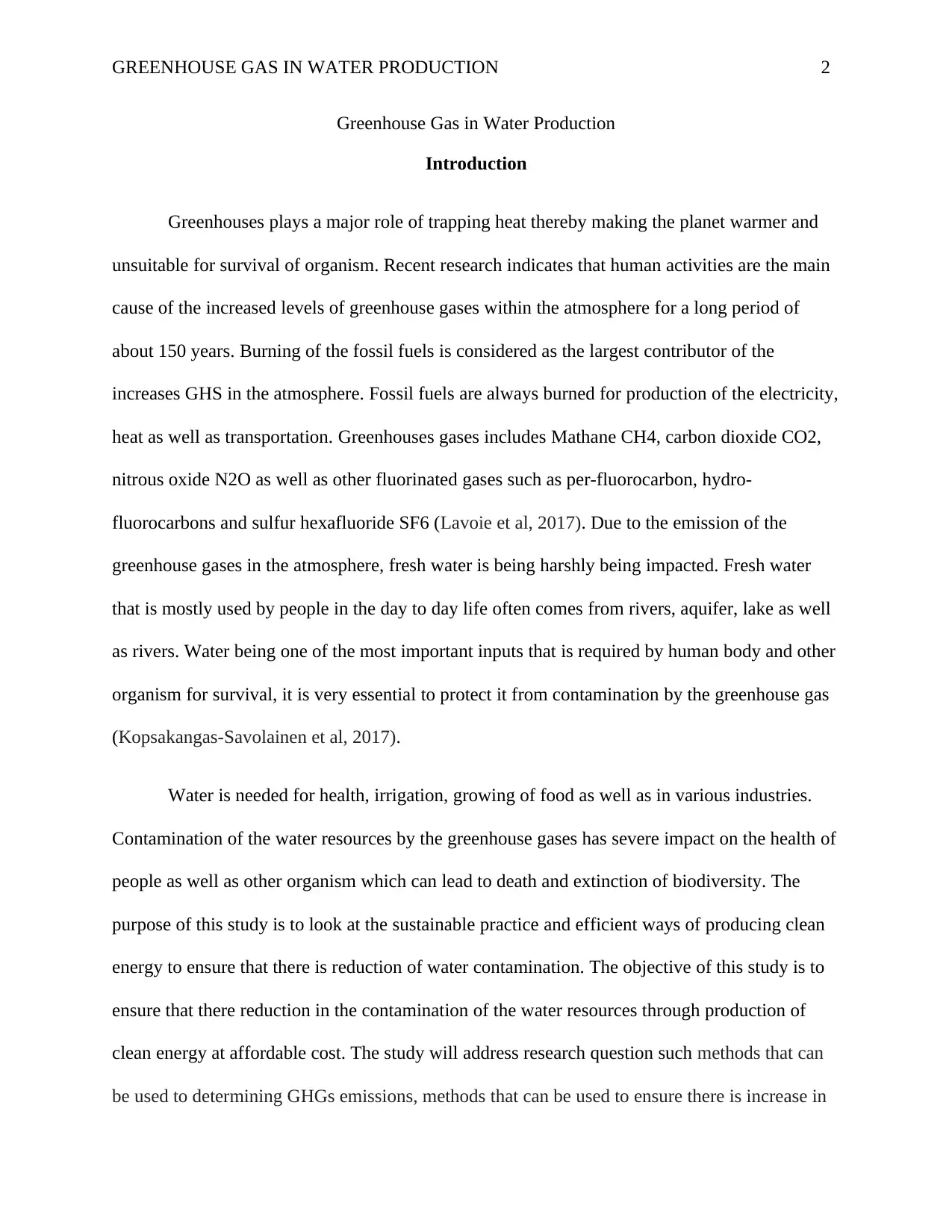
GREENHOUSE GAS IN WATER PRODUCTION 2
Greenhouse Gas in Water Production
Introduction
Greenhouses plays a major role of trapping heat thereby making the planet warmer and
unsuitable for survival of organism. Recent research indicates that human activities are the main
cause of the increased levels of greenhouse gases within the atmosphere for a long period of
about 150 years. Burning of the fossil fuels is considered as the largest contributor of the
increases GHS in the atmosphere. Fossil fuels are always burned for production of the electricity,
heat as well as transportation. Greenhouses gases includes Mathane CH4, carbon dioxide CO2,
nitrous oxide N2O as well as other fluorinated gases such as per-fluorocarbon, hydro-
fluorocarbons and sulfur hexafluoride SF6 (Lavoie et al, 2017). Due to the emission of the
greenhouse gases in the atmosphere, fresh water is being harshly being impacted. Fresh water
that is mostly used by people in the day to day life often comes from rivers, aquifer, lake as well
as rivers. Water being one of the most important inputs that is required by human body and other
organism for survival, it is very essential to protect it from contamination by the greenhouse gas
(Kopsakangas-Savolainen et al, 2017).
Water is needed for health, irrigation, growing of food as well as in various industries.
Contamination of the water resources by the greenhouse gases has severe impact on the health of
people as well as other organism which can lead to death and extinction of biodiversity. The
purpose of this study is to look at the sustainable practice and efficient ways of producing clean
energy to ensure that there is reduction of water contamination. The objective of this study is to
ensure that there reduction in the contamination of the water resources through production of
clean energy at affordable cost. The study will address research question such methods that can
be used to determining GHGs emissions, methods that can be used to ensure there is increase in
Greenhouse Gas in Water Production
Introduction
Greenhouses plays a major role of trapping heat thereby making the planet warmer and
unsuitable for survival of organism. Recent research indicates that human activities are the main
cause of the increased levels of greenhouse gases within the atmosphere for a long period of
about 150 years. Burning of the fossil fuels is considered as the largest contributor of the
increases GHS in the atmosphere. Fossil fuels are always burned for production of the electricity,
heat as well as transportation. Greenhouses gases includes Mathane CH4, carbon dioxide CO2,
nitrous oxide N2O as well as other fluorinated gases such as per-fluorocarbon, hydro-
fluorocarbons and sulfur hexafluoride SF6 (Lavoie et al, 2017). Due to the emission of the
greenhouse gases in the atmosphere, fresh water is being harshly being impacted. Fresh water
that is mostly used by people in the day to day life often comes from rivers, aquifer, lake as well
as rivers. Water being one of the most important inputs that is required by human body and other
organism for survival, it is very essential to protect it from contamination by the greenhouse gas
(Kopsakangas-Savolainen et al, 2017).
Water is needed for health, irrigation, growing of food as well as in various industries.
Contamination of the water resources by the greenhouse gases has severe impact on the health of
people as well as other organism which can lead to death and extinction of biodiversity. The
purpose of this study is to look at the sustainable practice and efficient ways of producing clean
energy to ensure that there is reduction of water contamination. The objective of this study is to
ensure that there reduction in the contamination of the water resources through production of
clean energy at affordable cost. The study will address research question such methods that can
be used to determining GHGs emissions, methods that can be used to ensure there is increase in

GREENHOUSE GAS IN WATER PRODUCTION 3
the energy use efficiency among others. The significance of this project is to ensure that there is
reduction in the spread of water borne diseases caused by contaminated water by greenhouse
gases. The scope of this project mainly looks at the water resources and greenhouse gases
production and their respective effects on the biodiversity.
Background
Since, 1990, there has been increase in the emission of the greenhouse gas. United
State experienced an increase of the greenhouse gas by 2 percent in the year 1990.
Greenhouse gas emission always rises and fall year in year out as a result of changes in the
economy, fuel price among other factors. GHGs occur naturally; however, there emission of
these gases increases as a result of the increases in the human activities. Concentration of
human GHGs gases increases in the atmosphere are artificially increased by activities being
undertaken by the human activities (Shailesh, 2013). Fresh water is essential for human
survival, not only for drinking but also for various activities such as washing, farming among
others.
Huang & Chen (2017) indicated that water supply is expected to increasingly become
scarce in the near future due to the increase contamination by the GHGs. Understanding the
problem of water scarcity start by taking into consideration how it is distributed within the
planet. Study indicates that 98 percent of the available water is salty. Therefore, this only
leaves 2 percent of the fresh water for human consumption and other uses. However, of this 2
percent almost 70percent is in the form of ice and snow, 30 percent being the ground water
leaving only 0.5 percent as surface water (rivers as well as lakes). Additionally, only 0.5
percent is available in the atmosphere. According to the research, greenhouse gases causes’
the energy use efficiency among others. The significance of this project is to ensure that there is
reduction in the spread of water borne diseases caused by contaminated water by greenhouse
gases. The scope of this project mainly looks at the water resources and greenhouse gases
production and their respective effects on the biodiversity.
Background
Since, 1990, there has been increase in the emission of the greenhouse gas. United
State experienced an increase of the greenhouse gas by 2 percent in the year 1990.
Greenhouse gas emission always rises and fall year in year out as a result of changes in the
economy, fuel price among other factors. GHGs occur naturally; however, there emission of
these gases increases as a result of the increases in the human activities. Concentration of
human GHGs gases increases in the atmosphere are artificially increased by activities being
undertaken by the human activities (Shailesh, 2013). Fresh water is essential for human
survival, not only for drinking but also for various activities such as washing, farming among
others.
Huang & Chen (2017) indicated that water supply is expected to increasingly become
scarce in the near future due to the increase contamination by the GHGs. Understanding the
problem of water scarcity start by taking into consideration how it is distributed within the
planet. Study indicates that 98 percent of the available water is salty. Therefore, this only
leaves 2 percent of the fresh water for human consumption and other uses. However, of this 2
percent almost 70percent is in the form of ice and snow, 30 percent being the ground water
leaving only 0.5 percent as surface water (rivers as well as lakes). Additionally, only 0.5
percent is available in the atmosphere. According to the research, greenhouse gases causes’
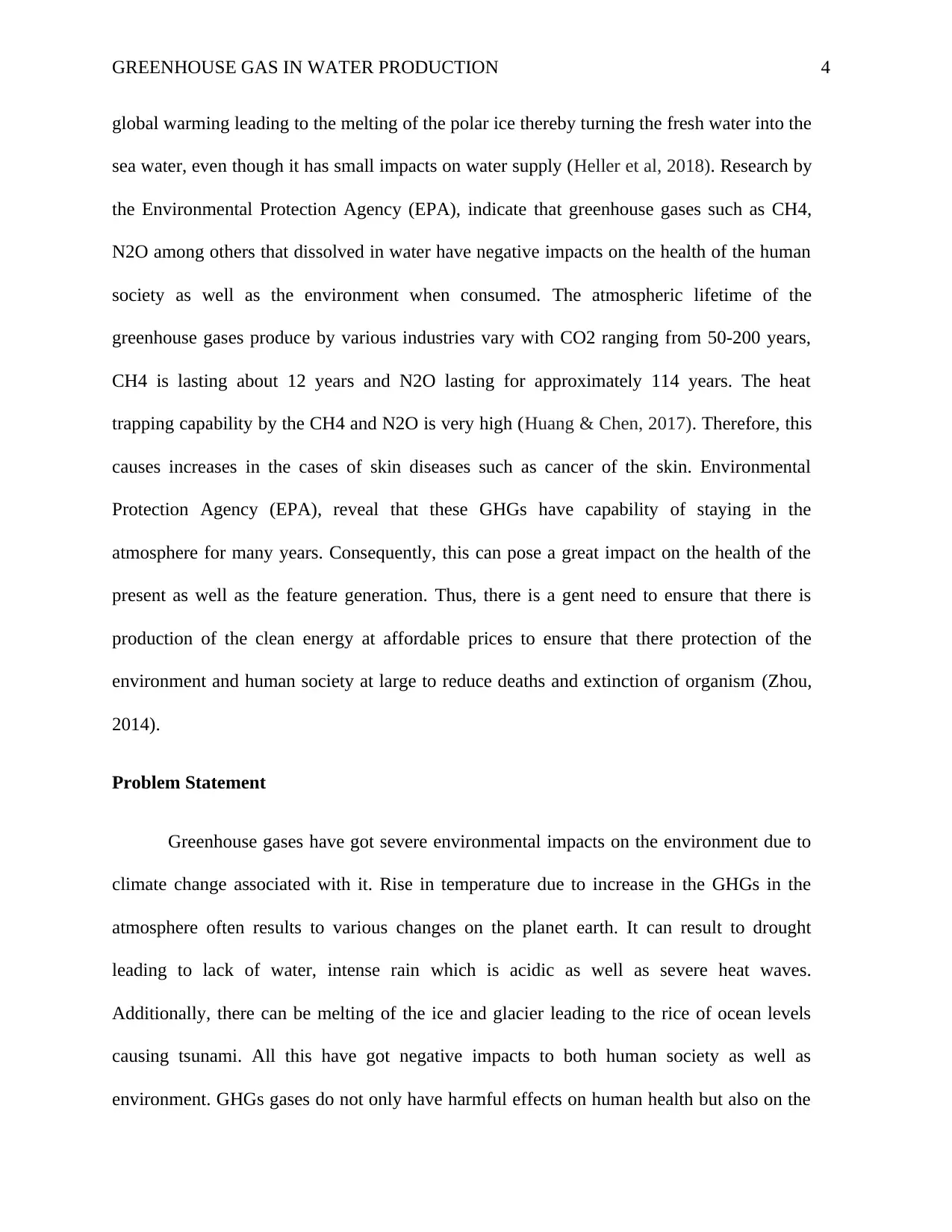
GREENHOUSE GAS IN WATER PRODUCTION 4
global warming leading to the melting of the polar ice thereby turning the fresh water into the
sea water, even though it has small impacts on water supply (Heller et al, 2018). Research by
the Environmental Protection Agency (EPA), indicate that greenhouse gases such as CH4,
N2O among others that dissolved in water have negative impacts on the health of the human
society as well as the environment when consumed. The atmospheric lifetime of the
greenhouse gases produce by various industries vary with CO2 ranging from 50-200 years,
CH4 is lasting about 12 years and N2O lasting for approximately 114 years. The heat
trapping capability by the CH4 and N2O is very high (Huang & Chen, 2017). Therefore, this
causes increases in the cases of skin diseases such as cancer of the skin. Environmental
Protection Agency (EPA), reveal that these GHGs have capability of staying in the
atmosphere for many years. Consequently, this can pose a great impact on the health of the
present as well as the feature generation. Thus, there is a gent need to ensure that there is
production of the clean energy at affordable prices to ensure that there protection of the
environment and human society at large to reduce deaths and extinction of organism (Zhou,
2014).
Problem Statement
Greenhouse gases have got severe environmental impacts on the environment due to
climate change associated with it. Rise in temperature due to increase in the GHGs in the
atmosphere often results to various changes on the planet earth. It can result to drought
leading to lack of water, intense rain which is acidic as well as severe heat waves.
Additionally, there can be melting of the ice and glacier leading to the rice of ocean levels
causing tsunami. All this have got negative impacts to both human society as well as
environment. GHGs gases do not only have harmful effects on human health but also on the
global warming leading to the melting of the polar ice thereby turning the fresh water into the
sea water, even though it has small impacts on water supply (Heller et al, 2018). Research by
the Environmental Protection Agency (EPA), indicate that greenhouse gases such as CH4,
N2O among others that dissolved in water have negative impacts on the health of the human
society as well as the environment when consumed. The atmospheric lifetime of the
greenhouse gases produce by various industries vary with CO2 ranging from 50-200 years,
CH4 is lasting about 12 years and N2O lasting for approximately 114 years. The heat
trapping capability by the CH4 and N2O is very high (Huang & Chen, 2017). Therefore, this
causes increases in the cases of skin diseases such as cancer of the skin. Environmental
Protection Agency (EPA), reveal that these GHGs have capability of staying in the
atmosphere for many years. Consequently, this can pose a great impact on the health of the
present as well as the feature generation. Thus, there is a gent need to ensure that there is
production of the clean energy at affordable prices to ensure that there protection of the
environment and human society at large to reduce deaths and extinction of organism (Zhou,
2014).
Problem Statement
Greenhouse gases have got severe environmental impacts on the environment due to
climate change associated with it. Rise in temperature due to increase in the GHGs in the
atmosphere often results to various changes on the planet earth. It can result to drought
leading to lack of water, intense rain which is acidic as well as severe heat waves.
Additionally, there can be melting of the ice and glacier leading to the rice of ocean levels
causing tsunami. All this have got negative impacts to both human society as well as
environment. GHGs gases do not only have harmful effects on human health but also on the
Paraphrase This Document
Need a fresh take? Get an instant paraphrase of this document with our AI Paraphraser
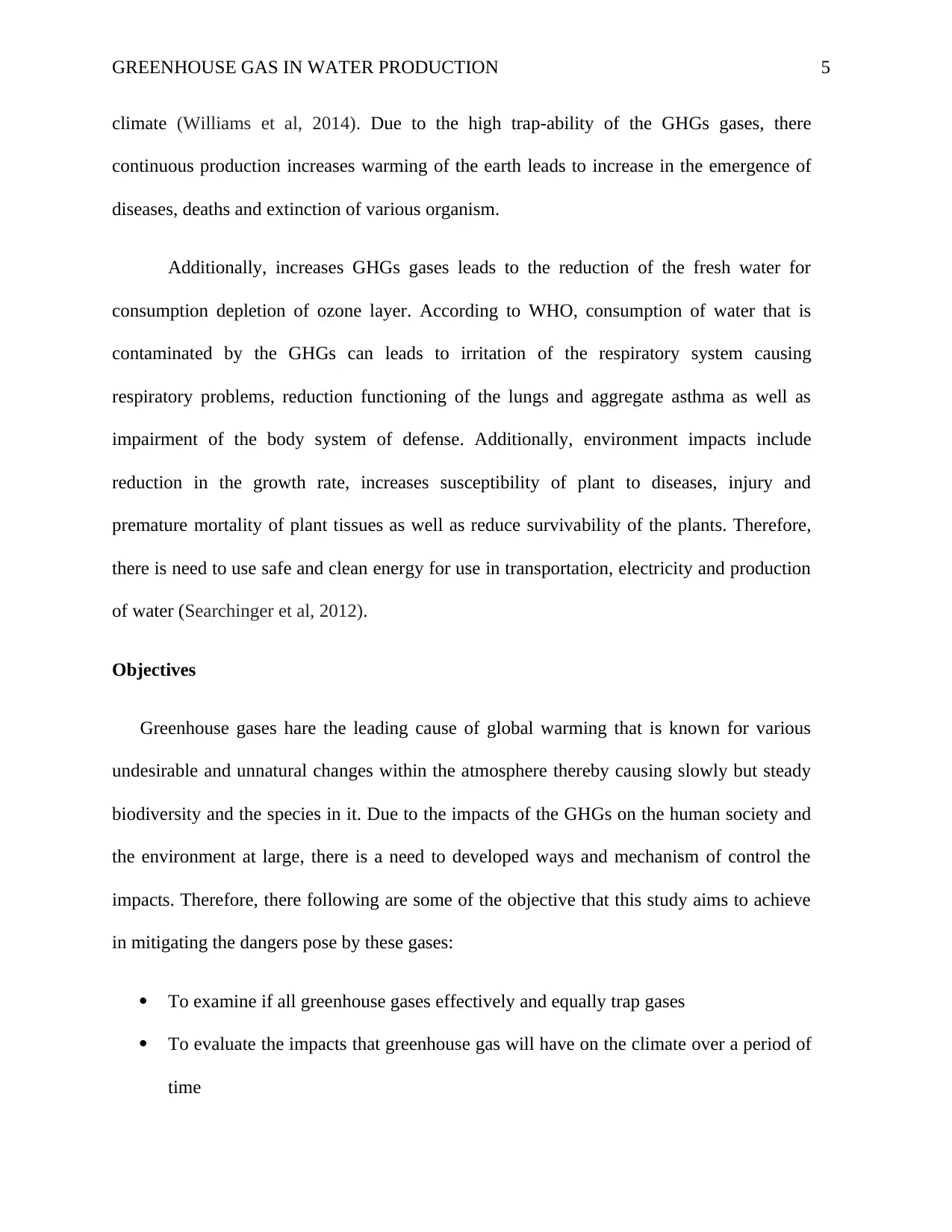
GREENHOUSE GAS IN WATER PRODUCTION 5
climate (Williams et al, 2014). Due to the high trap-ability of the GHGs gases, there
continuous production increases warming of the earth leads to increase in the emergence of
diseases, deaths and extinction of various organism.
Additionally, increases GHGs gases leads to the reduction of the fresh water for
consumption depletion of ozone layer. According to WHO, consumption of water that is
contaminated by the GHGs can leads to irritation of the respiratory system causing
respiratory problems, reduction functioning of the lungs and aggregate asthma as well as
impairment of the body system of defense. Additionally, environment impacts include
reduction in the growth rate, increases susceptibility of plant to diseases, injury and
premature mortality of plant tissues as well as reduce survivability of the plants. Therefore,
there is need to use safe and clean energy for use in transportation, electricity and production
of water (Searchinger et al, 2012).
Objectives
Greenhouse gases hare the leading cause of global warming that is known for various
undesirable and unnatural changes within the atmosphere thereby causing slowly but steady
biodiversity and the species in it. Due to the impacts of the GHGs on the human society and
the environment at large, there is a need to developed ways and mechanism of control the
impacts. Therefore, there following are some of the objective that this study aims to achieve
in mitigating the dangers pose by these gases:
To examine if all greenhouse gases effectively and equally trap gases
To evaluate the impacts that greenhouse gas will have on the climate over a period of
time
climate (Williams et al, 2014). Due to the high trap-ability of the GHGs gases, there
continuous production increases warming of the earth leads to increase in the emergence of
diseases, deaths and extinction of various organism.
Additionally, increases GHGs gases leads to the reduction of the fresh water for
consumption depletion of ozone layer. According to WHO, consumption of water that is
contaminated by the GHGs can leads to irritation of the respiratory system causing
respiratory problems, reduction functioning of the lungs and aggregate asthma as well as
impairment of the body system of defense. Additionally, environment impacts include
reduction in the growth rate, increases susceptibility of plant to diseases, injury and
premature mortality of plant tissues as well as reduce survivability of the plants. Therefore,
there is need to use safe and clean energy for use in transportation, electricity and production
of water (Searchinger et al, 2012).
Objectives
Greenhouse gases hare the leading cause of global warming that is known for various
undesirable and unnatural changes within the atmosphere thereby causing slowly but steady
biodiversity and the species in it. Due to the impacts of the GHGs on the human society and
the environment at large, there is a need to developed ways and mechanism of control the
impacts. Therefore, there following are some of the objective that this study aims to achieve
in mitigating the dangers pose by these gases:
To examine if all greenhouse gases effectively and equally trap gases
To evaluate the impacts that greenhouse gas will have on the climate over a period of
time
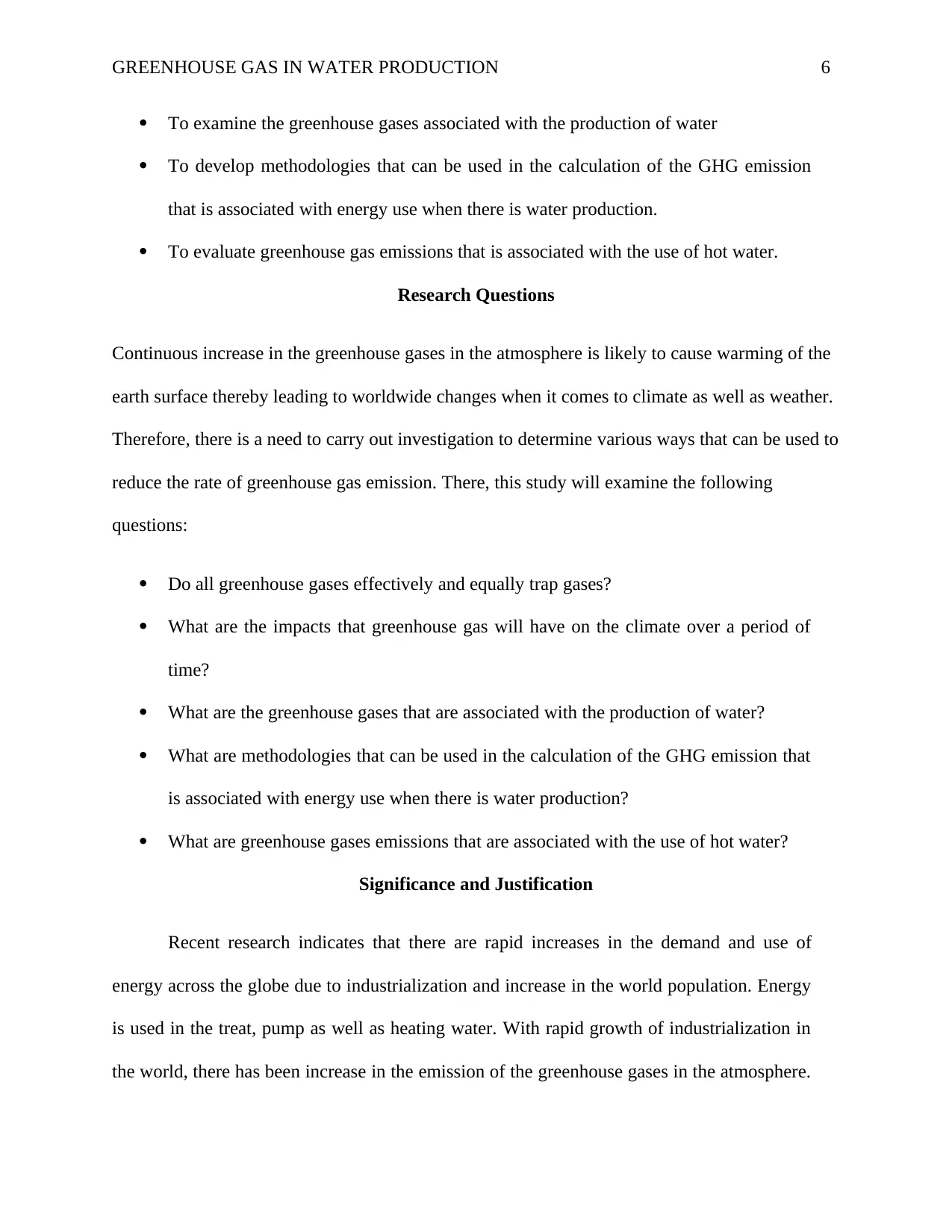
GREENHOUSE GAS IN WATER PRODUCTION 6
To examine the greenhouse gases associated with the production of water
To develop methodologies that can be used in the calculation of the GHG emission
that is associated with energy use when there is water production.
To evaluate greenhouse gas emissions that is associated with the use of hot water.
Research Questions
Continuous increase in the greenhouse gases in the atmosphere is likely to cause warming of the
earth surface thereby leading to worldwide changes when it comes to climate as well as weather.
Therefore, there is a need to carry out investigation to determine various ways that can be used to
reduce the rate of greenhouse gas emission. There, this study will examine the following
questions:
Do all greenhouse gases effectively and equally trap gases?
What are the impacts that greenhouse gas will have on the climate over a period of
time?
What are the greenhouse gases that are associated with the production of water?
What are methodologies that can be used in the calculation of the GHG emission that
is associated with energy use when there is water production?
What are greenhouse gases emissions that are associated with the use of hot water?
Significance and Justification
Recent research indicates that there are rapid increases in the demand and use of
energy across the globe due to industrialization and increase in the world population. Energy
is used in the treat, pump as well as heating water. With rapid growth of industrialization in
the world, there has been increase in the emission of the greenhouse gases in the atmosphere.
To examine the greenhouse gases associated with the production of water
To develop methodologies that can be used in the calculation of the GHG emission
that is associated with energy use when there is water production.
To evaluate greenhouse gas emissions that is associated with the use of hot water.
Research Questions
Continuous increase in the greenhouse gases in the atmosphere is likely to cause warming of the
earth surface thereby leading to worldwide changes when it comes to climate as well as weather.
Therefore, there is a need to carry out investigation to determine various ways that can be used to
reduce the rate of greenhouse gas emission. There, this study will examine the following
questions:
Do all greenhouse gases effectively and equally trap gases?
What are the impacts that greenhouse gas will have on the climate over a period of
time?
What are the greenhouse gases that are associated with the production of water?
What are methodologies that can be used in the calculation of the GHG emission that
is associated with energy use when there is water production?
What are greenhouse gases emissions that are associated with the use of hot water?
Significance and Justification
Recent research indicates that there are rapid increases in the demand and use of
energy across the globe due to industrialization and increase in the world population. Energy
is used in the treat, pump as well as heating water. With rapid growth of industrialization in
the world, there has been increase in the emission of the greenhouse gases in the atmosphere.
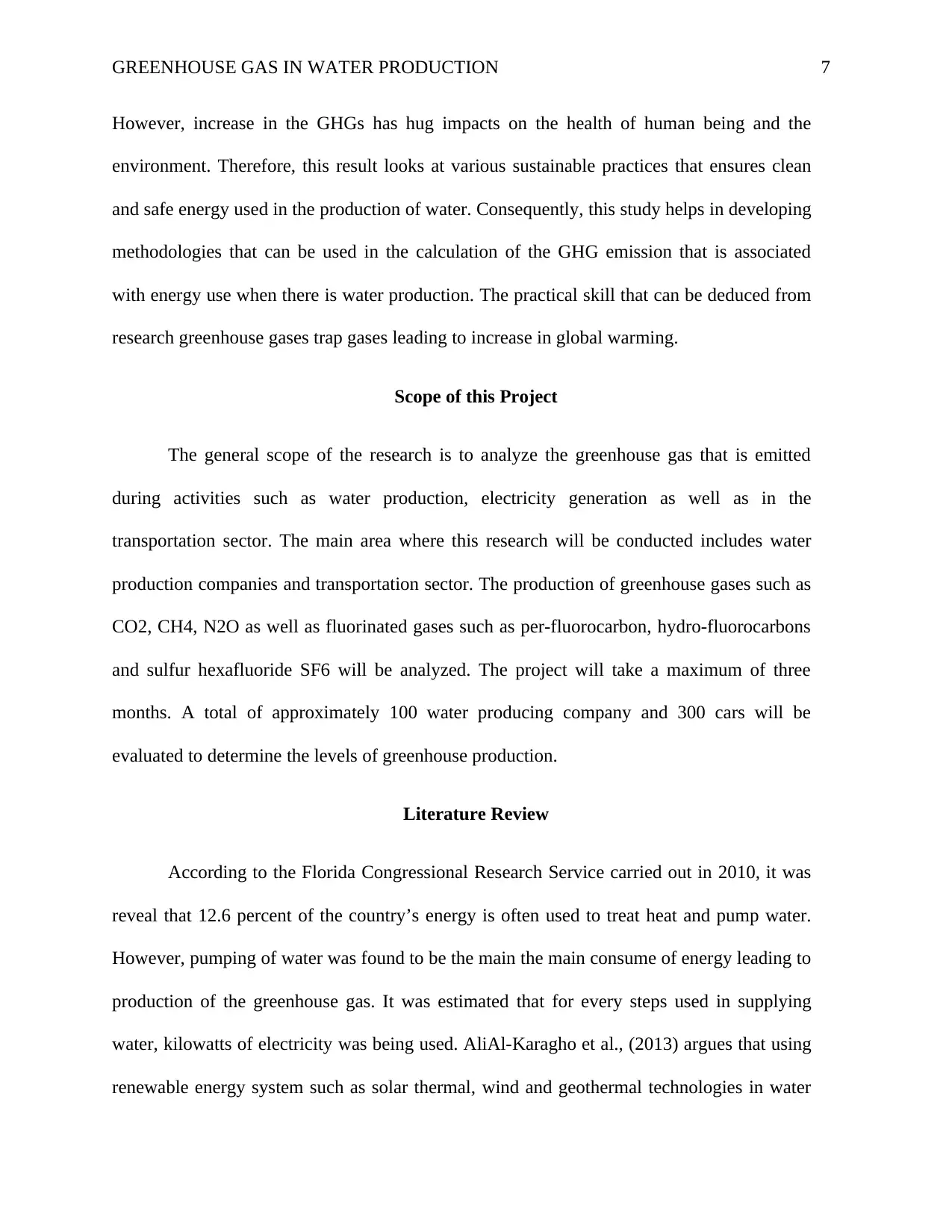
GREENHOUSE GAS IN WATER PRODUCTION 7
However, increase in the GHGs has hug impacts on the health of human being and the
environment. Therefore, this result looks at various sustainable practices that ensures clean
and safe energy used in the production of water. Consequently, this study helps in developing
methodologies that can be used in the calculation of the GHG emission that is associated
with energy use when there is water production. The practical skill that can be deduced from
research greenhouse gases trap gases leading to increase in global warming.
Scope of this Project
The general scope of the research is to analyze the greenhouse gas that is emitted
during activities such as water production, electricity generation as well as in the
transportation sector. The main area where this research will be conducted includes water
production companies and transportation sector. The production of greenhouse gases such as
CO2, CH4, N2O as well as fluorinated gases such as per-fluorocarbon, hydro-fluorocarbons
and sulfur hexafluoride SF6 will be analyzed. The project will take a maximum of three
months. A total of approximately 100 water producing company and 300 cars will be
evaluated to determine the levels of greenhouse production.
Literature Review
According to the Florida Congressional Research Service carried out in 2010, it was
reveal that 12.6 percent of the country’s energy is often used to treat heat and pump water.
However, pumping of water was found to be the main the main consume of energy leading to
production of the greenhouse gas. It was estimated that for every steps used in supplying
water, kilowatts of electricity was being used. AliAl-Karagho et al., (2013) argues that using
renewable energy system such as solar thermal, wind and geothermal technologies in water
However, increase in the GHGs has hug impacts on the health of human being and the
environment. Therefore, this result looks at various sustainable practices that ensures clean
and safe energy used in the production of water. Consequently, this study helps in developing
methodologies that can be used in the calculation of the GHG emission that is associated
with energy use when there is water production. The practical skill that can be deduced from
research greenhouse gases trap gases leading to increase in global warming.
Scope of this Project
The general scope of the research is to analyze the greenhouse gas that is emitted
during activities such as water production, electricity generation as well as in the
transportation sector. The main area where this research will be conducted includes water
production companies and transportation sector. The production of greenhouse gases such as
CO2, CH4, N2O as well as fluorinated gases such as per-fluorocarbon, hydro-fluorocarbons
and sulfur hexafluoride SF6 will be analyzed. The project will take a maximum of three
months. A total of approximately 100 water producing company and 300 cars will be
evaluated to determine the levels of greenhouse production.
Literature Review
According to the Florida Congressional Research Service carried out in 2010, it was
reveal that 12.6 percent of the country’s energy is often used to treat heat and pump water.
However, pumping of water was found to be the main the main consume of energy leading to
production of the greenhouse gas. It was estimated that for every steps used in supplying
water, kilowatts of electricity was being used. AliAl-Karagho et al., (2013) argues that using
renewable energy system such as solar thermal, wind and geothermal technologies in water
Secure Best Marks with AI Grader
Need help grading? Try our AI Grader for instant feedback on your assignments.
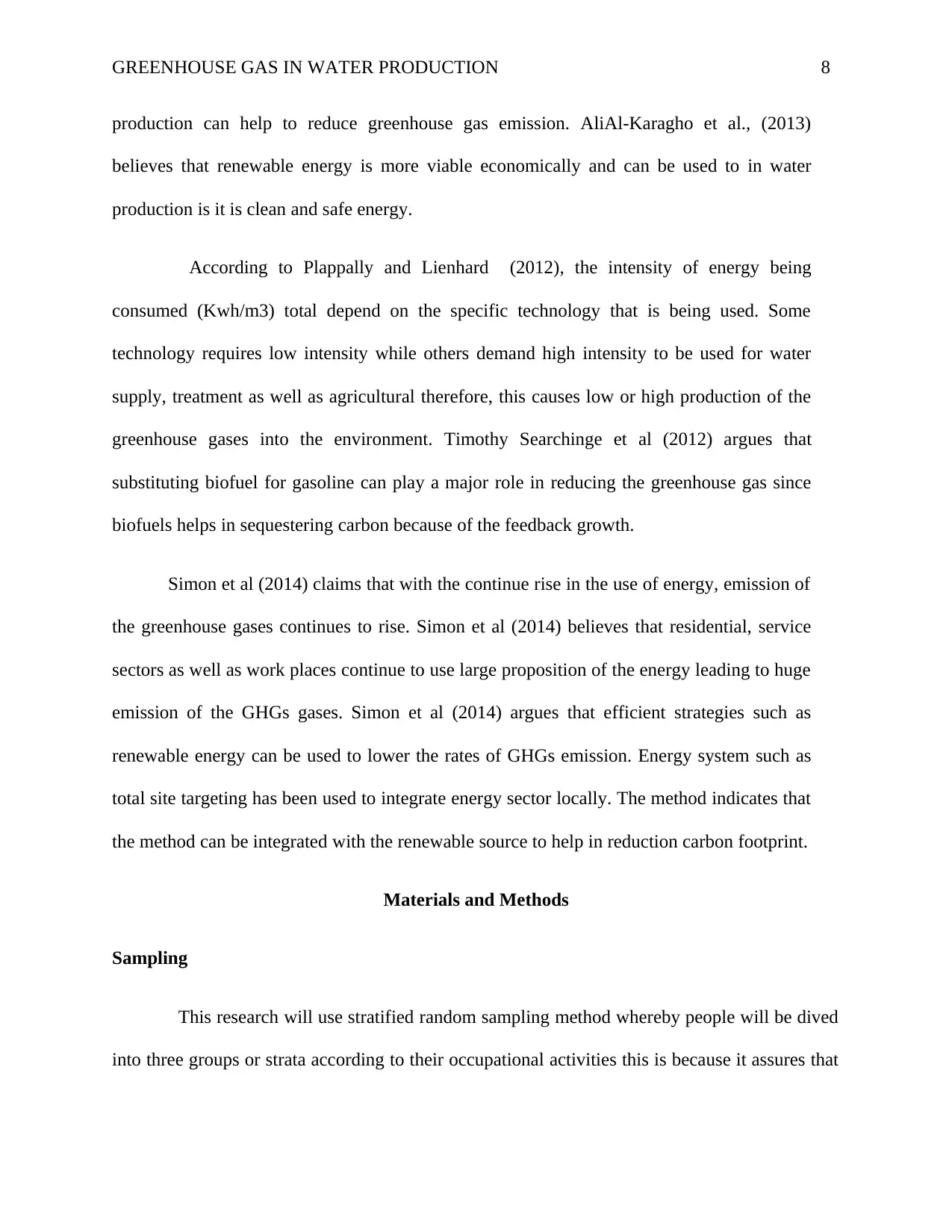
GREENHOUSE GAS IN WATER PRODUCTION 8
production can help to reduce greenhouse gas emission. AliAl-Karagho et al., (2013)
believes that renewable energy is more viable economically and can be used to in water
production is it is clean and safe energy.
According to Plappally and Lienhard (2012), the intensity of energy being
consumed (Kwh/m3) total depend on the specific technology that is being used. Some
technology requires low intensity while others demand high intensity to be used for water
supply, treatment as well as agricultural therefore, this causes low or high production of the
greenhouse gases into the environment. Timothy Searchinge et al (2012) argues that
substituting biofuel for gasoline can play a major role in reducing the greenhouse gas since
biofuels helps in sequestering carbon because of the feedback growth.
Simon et al (2014) claims that with the continue rise in the use of energy, emission of
the greenhouse gases continues to rise. Simon et al (2014) believes that residential, service
sectors as well as work places continue to use large proposition of the energy leading to huge
emission of the GHGs gases. Simon et al (2014) argues that efficient strategies such as
renewable energy can be used to lower the rates of GHGs emission. Energy system such as
total site targeting has been used to integrate energy sector locally. The method indicates that
the method can be integrated with the renewable source to help in reduction carbon footprint.
Materials and Methods
Sampling
This research will use stratified random sampling method whereby people will be dived
into three groups or strata according to their occupational activities this is because it assures that
production can help to reduce greenhouse gas emission. AliAl-Karagho et al., (2013)
believes that renewable energy is more viable economically and can be used to in water
production is it is clean and safe energy.
According to Plappally and Lienhard (2012), the intensity of energy being
consumed (Kwh/m3) total depend on the specific technology that is being used. Some
technology requires low intensity while others demand high intensity to be used for water
supply, treatment as well as agricultural therefore, this causes low or high production of the
greenhouse gases into the environment. Timothy Searchinge et al (2012) argues that
substituting biofuel for gasoline can play a major role in reducing the greenhouse gas since
biofuels helps in sequestering carbon because of the feedback growth.
Simon et al (2014) claims that with the continue rise in the use of energy, emission of
the greenhouse gases continues to rise. Simon et al (2014) believes that residential, service
sectors as well as work places continue to use large proposition of the energy leading to huge
emission of the GHGs gases. Simon et al (2014) argues that efficient strategies such as
renewable energy can be used to lower the rates of GHGs emission. Energy system such as
total site targeting has been used to integrate energy sector locally. The method indicates that
the method can be integrated with the renewable source to help in reduction carbon footprint.
Materials and Methods
Sampling
This research will use stratified random sampling method whereby people will be dived
into three groups or strata according to their occupational activities this is because it assures that
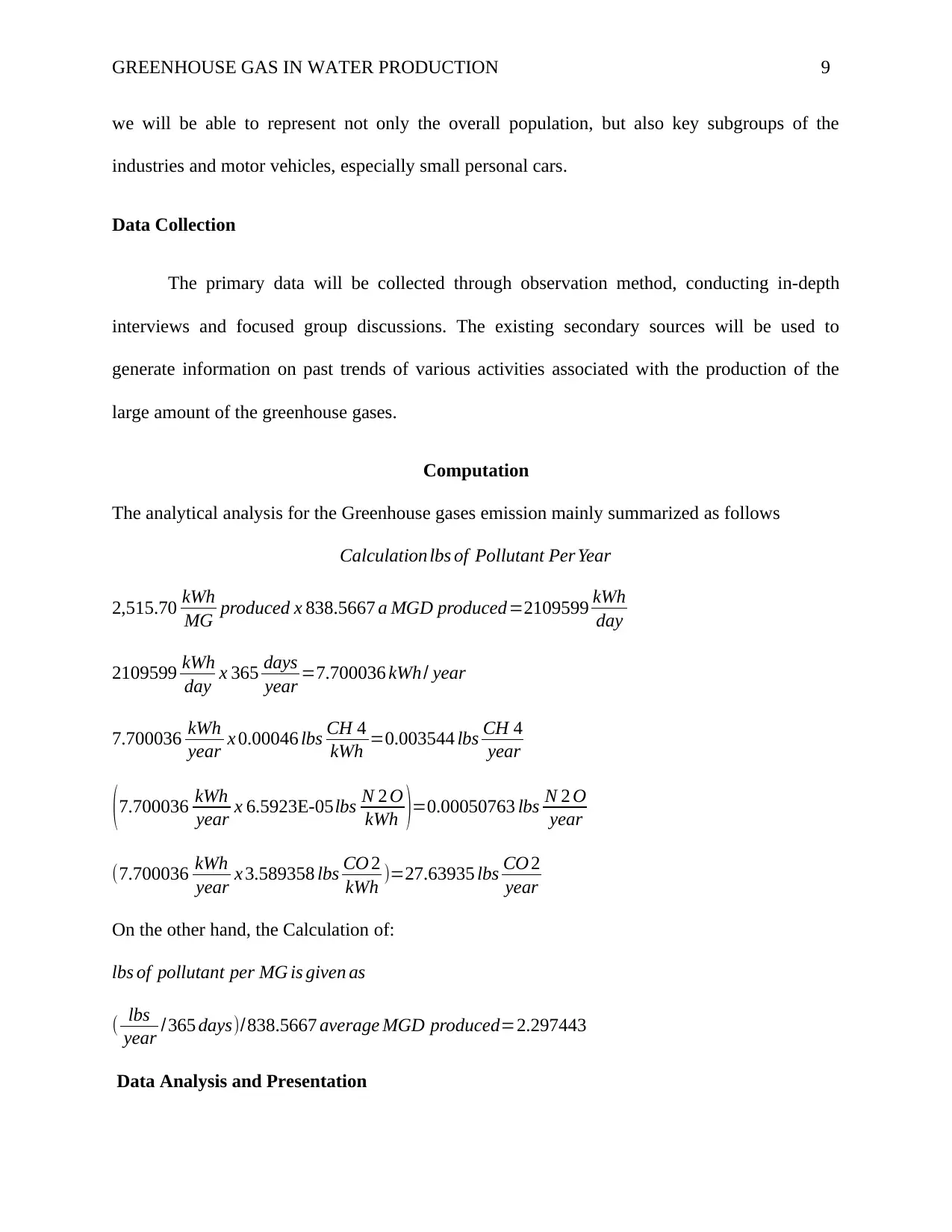
GREENHOUSE GAS IN WATER PRODUCTION 9
we will be able to represent not only the overall population, but also key subgroups of the
industries and motor vehicles, especially small personal cars.
Data Collection
The primary data will be collected through observation method, conducting in-depth
interviews and focused group discussions. The existing secondary sources will be used to
generate information on past trends of various activities associated with the production of the
large amount of the greenhouse gases.
Computation
The analytical analysis for the Greenhouse gases emission mainly summarized as follows
Calculation lbs of Pollutant Per Year
2,515.70 kWh
MG produced x 838.5667 a MGD produced=2109599 kWh
day
2109599 kWh
day x 365 days
year =7.700036 kWh/ year
7.700036 kWh
year x 0.00046 lbs CH 4
kWh =0.003544 lbs CH 4
year
(7.700036 kWh
year x 6.5923E-05lbs N 2 O
kWh )=0.00050763 lbs N 2 O
year
(7.700036 kWh
year x 3.589358 lbs CO 2
kWh )=27.63935 lbs CO 2
year
On the other hand, the Calculation of:
lbs of pollutant per MG is given as
( lbs
year /365 days)/838.5667 average MGD produced=2.297443
Data Analysis and Presentation
we will be able to represent not only the overall population, but also key subgroups of the
industries and motor vehicles, especially small personal cars.
Data Collection
The primary data will be collected through observation method, conducting in-depth
interviews and focused group discussions. The existing secondary sources will be used to
generate information on past trends of various activities associated with the production of the
large amount of the greenhouse gases.
Computation
The analytical analysis for the Greenhouse gases emission mainly summarized as follows
Calculation lbs of Pollutant Per Year
2,515.70 kWh
MG produced x 838.5667 a MGD produced=2109599 kWh
day
2109599 kWh
day x 365 days
year =7.700036 kWh/ year
7.700036 kWh
year x 0.00046 lbs CH 4
kWh =0.003544 lbs CH 4
year
(7.700036 kWh
year x 6.5923E-05lbs N 2 O
kWh )=0.00050763 lbs N 2 O
year
(7.700036 kWh
year x 3.589358 lbs CO 2
kWh )=27.63935 lbs CO 2
year
On the other hand, the Calculation of:
lbs of pollutant per MG is given as
( lbs
year /365 days)/838.5667 average MGD produced=2.297443
Data Analysis and Presentation
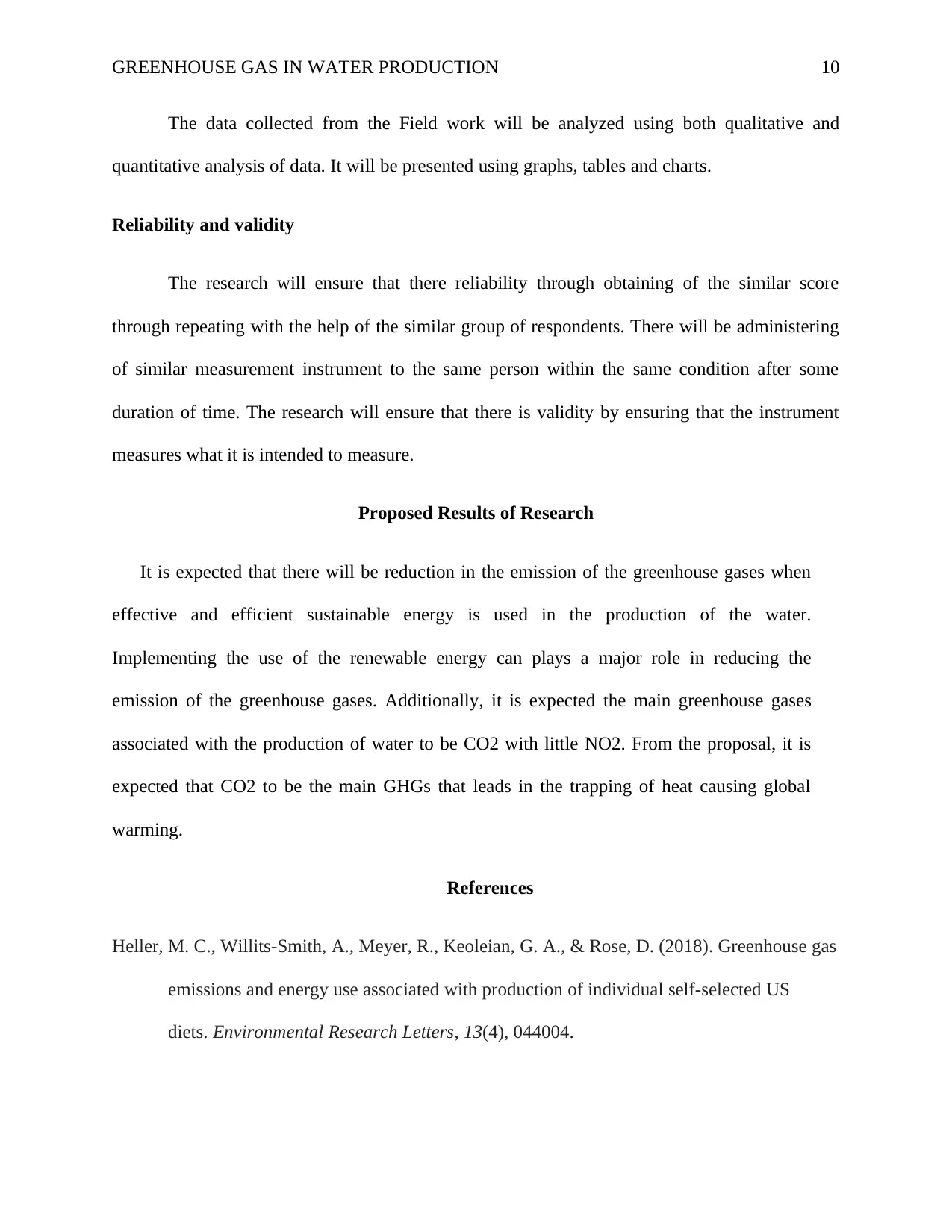
GREENHOUSE GAS IN WATER PRODUCTION 10
The data collected from the Field work will be analyzed using both qualitative and
quantitative analysis of data. It will be presented using graphs, tables and charts.
Reliability and validity
The research will ensure that there reliability through obtaining of the similar score
through repeating with the help of the similar group of respondents. There will be administering
of similar measurement instrument to the same person within the same condition after some
duration of time. The research will ensure that there is validity by ensuring that the instrument
measures what it is intended to measure.
Proposed Results of Research
It is expected that there will be reduction in the emission of the greenhouse gases when
effective and efficient sustainable energy is used in the production of the water.
Implementing the use of the renewable energy can plays a major role in reducing the
emission of the greenhouse gases. Additionally, it is expected the main greenhouse gases
associated with the production of water to be CO2 with little NO2. From the proposal, it is
expected that CO2 to be the main GHGs that leads in the trapping of heat causing global
warming.
References
Heller, M. C., Willits-Smith, A., Meyer, R., Keoleian, G. A., & Rose, D. (2018). Greenhouse gas
emissions and energy use associated with production of individual self-selected US
diets. Environmental Research Letters, 13(4), 044004.
The data collected from the Field work will be analyzed using both qualitative and
quantitative analysis of data. It will be presented using graphs, tables and charts.
Reliability and validity
The research will ensure that there reliability through obtaining of the similar score
through repeating with the help of the similar group of respondents. There will be administering
of similar measurement instrument to the same person within the same condition after some
duration of time. The research will ensure that there is validity by ensuring that the instrument
measures what it is intended to measure.
Proposed Results of Research
It is expected that there will be reduction in the emission of the greenhouse gases when
effective and efficient sustainable energy is used in the production of the water.
Implementing the use of the renewable energy can plays a major role in reducing the
emission of the greenhouse gases. Additionally, it is expected the main greenhouse gases
associated with the production of water to be CO2 with little NO2. From the proposal, it is
expected that CO2 to be the main GHGs that leads in the trapping of heat causing global
warming.
References
Heller, M. C., Willits-Smith, A., Meyer, R., Keoleian, G. A., & Rose, D. (2018). Greenhouse gas
emissions and energy use associated with production of individual self-selected US
diets. Environmental Research Letters, 13(4), 044004.
Paraphrase This Document
Need a fresh take? Get an instant paraphrase of this document with our AI Paraphraser
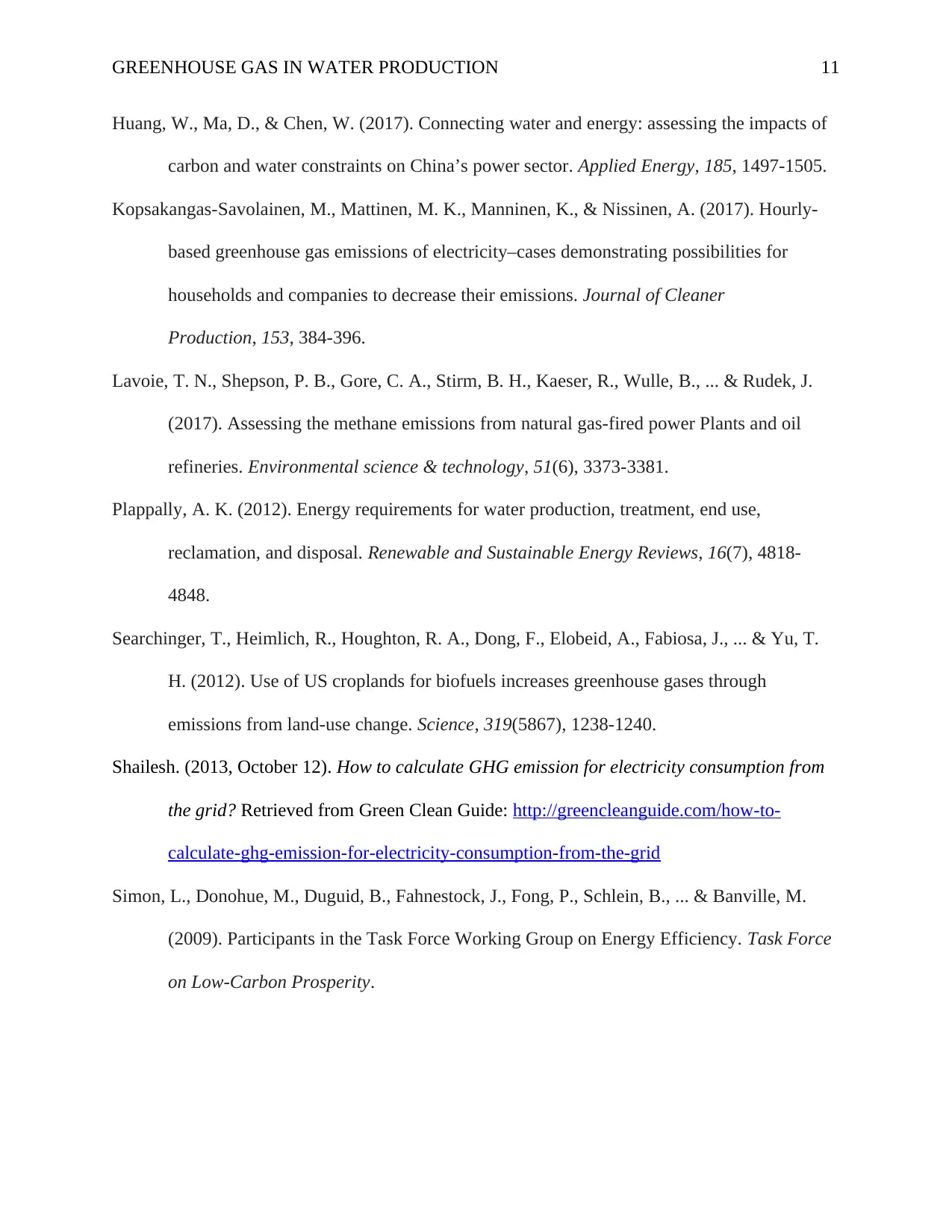
GREENHOUSE GAS IN WATER PRODUCTION 11
Huang, W., Ma, D., & Chen, W. (2017). Connecting water and energy: assessing the impacts of
carbon and water constraints on China’s power sector. Applied Energy, 185, 1497-1505.
Kopsakangas-Savolainen, M., Mattinen, M. K., Manninen, K., & Nissinen, A. (2017). Hourly-
based greenhouse gas emissions of electricity–cases demonstrating possibilities for
households and companies to decrease their emissions. Journal of Cleaner
Production, 153, 384-396.
Lavoie, T. N., Shepson, P. B., Gore, C. A., Stirm, B. H., Kaeser, R., Wulle, B., ... & Rudek, J.
(2017). Assessing the methane emissions from natural gas-fired power Plants and oil
refineries. Environmental science & technology, 51(6), 3373-3381.
Plappally, A. K. (2012). Energy requirements for water production, treatment, end use,
reclamation, and disposal. Renewable and Sustainable Energy Reviews, 16(7), 4818-
4848.
Searchinger, T., Heimlich, R., Houghton, R. A., Dong, F., Elobeid, A., Fabiosa, J., ... & Yu, T.
H. (2012). Use of US croplands for biofuels increases greenhouse gases through
emissions from land-use change. Science, 319(5867), 1238-1240.
Shailesh. (2013, October 12). How to calculate GHG emission for electricity consumption from
the grid? Retrieved from Green Clean Guide: http://greencleanguide.com/how-to-
calculate-ghg-emission-for-electricity-consumption-from-the-grid
Simon, L., Donohue, M., Duguid, B., Fahnestock, J., Fong, P., Schlein, B., ... & Banville, M.
(2009). Participants in the Task Force Working Group on Energy Efficiency. Task Force
on Low-Carbon Prosperity.
Huang, W., Ma, D., & Chen, W. (2017). Connecting water and energy: assessing the impacts of
carbon and water constraints on China’s power sector. Applied Energy, 185, 1497-1505.
Kopsakangas-Savolainen, M., Mattinen, M. K., Manninen, K., & Nissinen, A. (2017). Hourly-
based greenhouse gas emissions of electricity–cases demonstrating possibilities for
households and companies to decrease their emissions. Journal of Cleaner
Production, 153, 384-396.
Lavoie, T. N., Shepson, P. B., Gore, C. A., Stirm, B. H., Kaeser, R., Wulle, B., ... & Rudek, J.
(2017). Assessing the methane emissions from natural gas-fired power Plants and oil
refineries. Environmental science & technology, 51(6), 3373-3381.
Plappally, A. K. (2012). Energy requirements for water production, treatment, end use,
reclamation, and disposal. Renewable and Sustainable Energy Reviews, 16(7), 4818-
4848.
Searchinger, T., Heimlich, R., Houghton, R. A., Dong, F., Elobeid, A., Fabiosa, J., ... & Yu, T.
H. (2012). Use of US croplands for biofuels increases greenhouse gases through
emissions from land-use change. Science, 319(5867), 1238-1240.
Shailesh. (2013, October 12). How to calculate GHG emission for electricity consumption from
the grid? Retrieved from Green Clean Guide: http://greencleanguide.com/how-to-
calculate-ghg-emission-for-electricity-consumption-from-the-grid
Simon, L., Donohue, M., Duguid, B., Fahnestock, J., Fong, P., Schlein, B., ... & Banville, M.
(2009). Participants in the Task Force Working Group on Energy Efficiency. Task Force
on Low-Carbon Prosperity.

GREENHOUSE GAS IN WATER PRODUCTION 12
Williams, P. R., Inman, D., Aden, A., & Heath, G. A. (2014). Environmental and sustainability
factors associated with next-generation biofuels in the US: what do we really
know?. Environmental science & technology, 43(13), 4763-4775.
Zhou, Y. (2014). Combined Production of Electric Power and Heat: Proceedings of a Seminar
Organized by the Committee on Electric Power of the United Nations Economic
Commission for Europe, Hamburg, Federal Republic of Germany, 6-9 November 1978.
New York: Elsevier.
Williams, P. R., Inman, D., Aden, A., & Heath, G. A. (2014). Environmental and sustainability
factors associated with next-generation biofuels in the US: what do we really
know?. Environmental science & technology, 43(13), 4763-4775.
Zhou, Y. (2014). Combined Production of Electric Power and Heat: Proceedings of a Seminar
Organized by the Committee on Electric Power of the United Nations Economic
Commission for Europe, Hamburg, Federal Republic of Germany, 6-9 November 1978.
New York: Elsevier.
1 out of 12
Related Documents
Your All-in-One AI-Powered Toolkit for Academic Success.
+13062052269
info@desklib.com
Available 24*7 on WhatsApp / Email
![[object Object]](/_next/static/media/star-bottom.7253800d.svg)
Unlock your academic potential
© 2024 | Zucol Services PVT LTD | All rights reserved.





